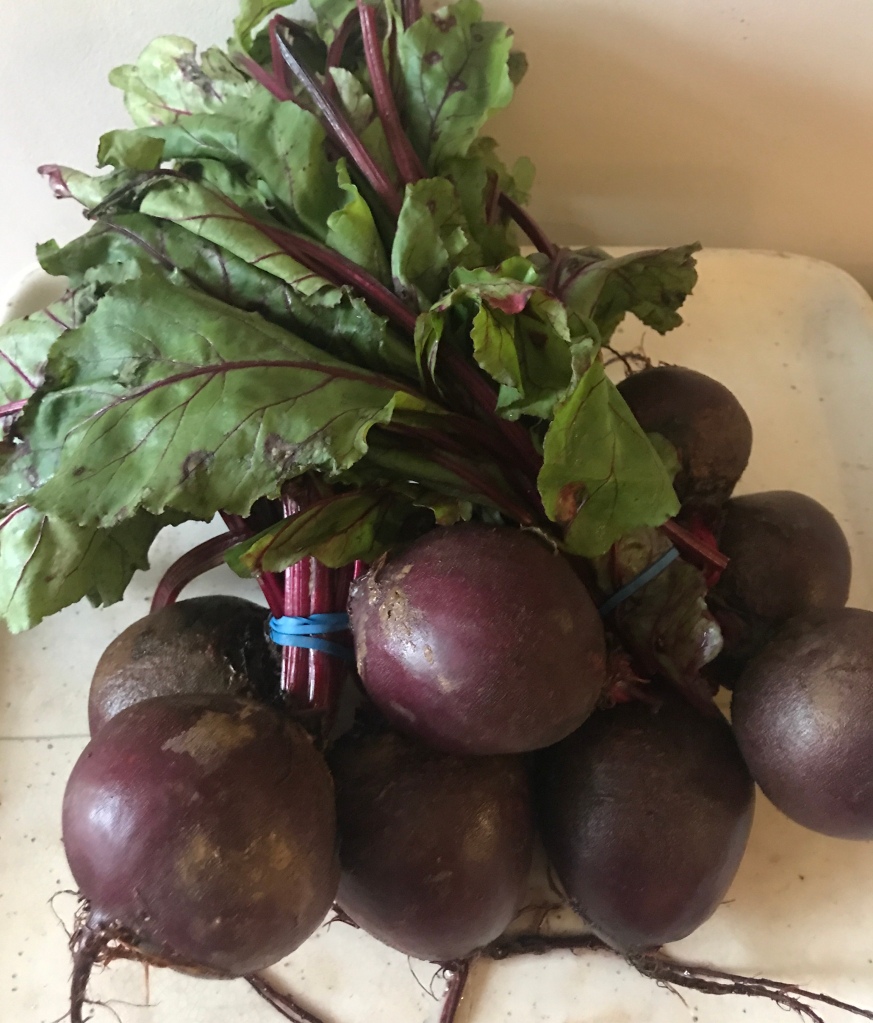
I stumbled on this recipe many years ago whilst devouring the book Nourishing Traditions by Sally Fallon. The book emphasises eating a traditional nutrient dense diet in much the same way as our fore-fathers had done, eating simple foods, as close to nature as possible and without lengthy ingredient lists. The premise is that if your grandmother doesn’t recognise the ingredients as food don’t eat it. Even so called “healthy food” can be overly processed and messed about with. This was one of the first recipes I tried and soon became a favourite. I always like having a jar of it in my fridge as it’s a quick and easy recipe that takes only three days from start to finish and with all the probiotic benefits that fermentation offers.
I have always loved eating pickled beetroot but fermenting them in this way makes them far superior as instead of being boiled and steeped in brown sugar and vinegar they’re lightly roasted and then lacto-fermented using a starter culture such as whey (If you don’t have fresh whey you can also use the juice of unpasteurised sauerkraut or a probiotic capsule). The result is a fantastic beetroot pickle bursting with life which literally tickles your tastebuds and is loaded with probiotic goodness.

Fermenting cooked vegetables is an unusual method as instead of harnessing the naturally occurring Lactobacillus bacteria abundant on all raw vegetables you use a starter culture to kickstart the fermentation. The two most common methods for Lacto-fermenting are either dry salting the vegetables or wet salting. You would use the dry salting method when making sauerkraut. Salt is added to the cabbage which pulls the water out of the cabbage by osmosis creating a brine. For a wet salt method you would make a salty brine and pour this over harder vegetables such as carrots, cauliflower or beetroots.

Beetroots are a phenomenal superfood packed with vitamins and minerals, anti oxidants and fibre. They are high in vitamin C, B6, folate, calcium, phosphorus, sodium potassium, iron and magnesium. They also contain unique phytonutrients called betalaines, two of these which have been extensively studied are Betanin and Vulgaxanthin which have been shown to provide powerful anti-oxidant, anti-inflammatory and detoxification properties. Beets have many exceptional health properties, when we eat beetroots certain bacteria in the mouth turn the nitrate present in beetroots into nitrite which in turn gets chemically changed into nitric-oxide which then causes your blood vessels to dilate, this dilation allows blood to flow more freely through your arteries. Beets are high in fibre which help to improve bowel function and keep your waste moving through the intestines. They are also rich in betacyanin compounds which are the reddish, purple pigments in beetroots which boost colon health and can positively impact certain types of cancer such as colon cancer.

You can eat these fermented beets as part of any meal, they are great to have on the side like a condiment or relish, I’m positive you will soon start to crave them. I also especially love them added to this salad.
Making Whey
I usually have whey as a by product from making my kefir thick like Greek yogurt you can read about that here. You can also make it by straining yoghurt. Line a sieve with a piece of cheesecloth or a large coffee filter and place over a bowl. Pour the yoghurt or kefir into the cloth, cover it and then allow it to drip through slowly somewhere cool for several hours or over night. The liquid whey will drip into the bowl while the yoghurt solids stay in the cloth creating a soft cheese or quark.

For best results
Beetroots contain high levels of natural sugar it is best not to over cook them, If they are overcooked the concentrated sugar can become quite thick and syrupy. This is completely fine and makes them a bit more jam like, but I find if I don’t over cook them this is less likely to happen. Either way they are still delicious!
Once you leave them to ferment resist the urge to open the jar for at least three days.
A perfectly harmless white yeast called kahm may occur on the surface of your ferment you can just skim this off.

Lacto-Fermented Roasted Beetroot
Enough for a 1 litre Kilner or mason jar
Ingredients
2 bunches of beetroots about 5-6 medium beets
seeds from 2 cardamom pods
1 tablespoon salt
4 tablespoons of clean whey, or 4tbls of raw sauerkraut juice or 2 good quality probiotic capsules
1 cup filtered water
Method
Place the beetroots on a tray and roast until just soft, do not overcook as this will concentrate the sugars too much, al dente is perfect.
Once cooked peel and cube or cut into batons. Place the beetroot into a half litre wide mouth kilner or mason jar.
Push your beets right down into the jar with your fingers.
Combine all the remaining ingredients and pour over the beetroots, add a bit more water if you need to.
Seal the top down of your jar and leave to ferment on your counter for 3 days at room temperature.
Try your very hardest not to open the jar for 3 days. They should be a little sharp with a slightly fizzy tingle. Put in the fridge where they will last up to a month or more.

2 thoughts on “Lacto-fermented Roasted Beetroot”